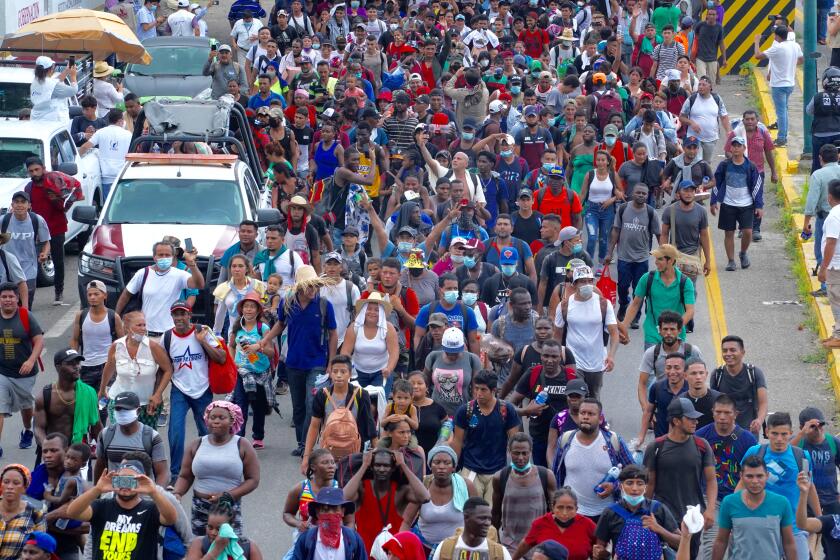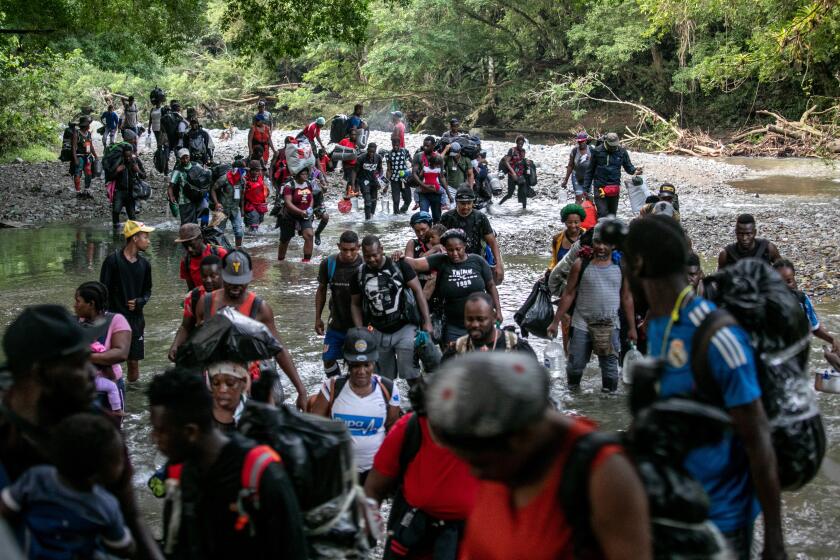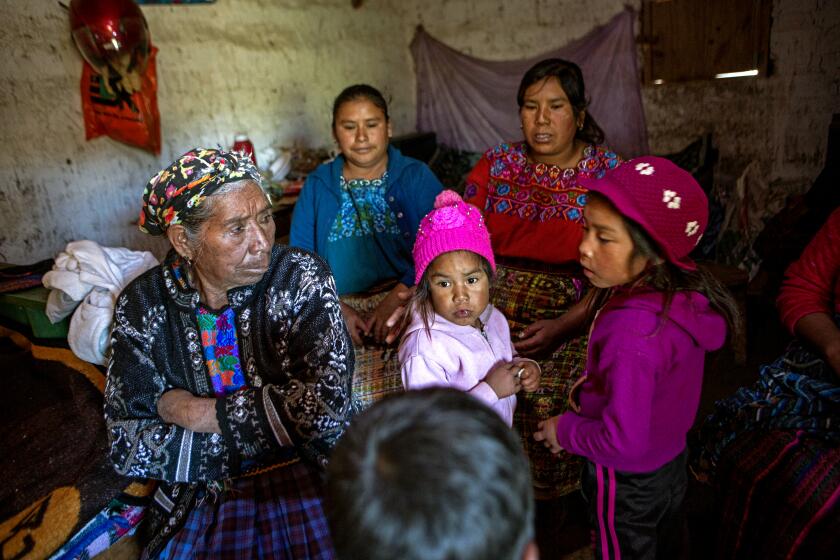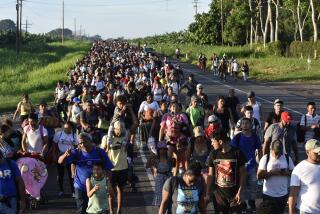Migrant caravan organizer says group will head for U.S. border after harassment in Mexico
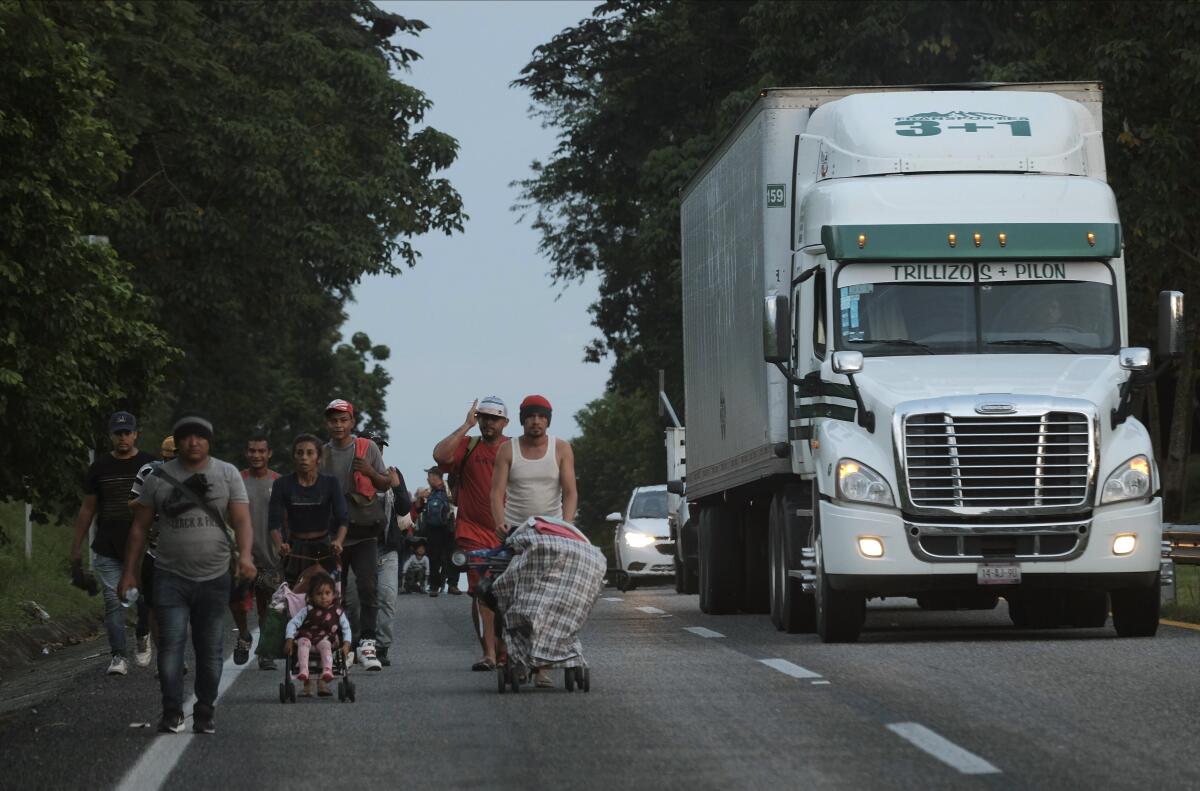
TAPACHULA, Mexico â The leader of an effort by Central American migrants to walk across southern Mexico said Monday that the group will now head to the U.S. border, rather than Mexico City as originally planned.
Leader and immigration activist Irineo Mujica said in a video that he would try to organize another caravan of thousands of migrants to reach the Gulf Coast state of Veracruz, where both groups will join up and set out for the southern U.S. border.
The apparent change in plans comes after Mujica said the group had been pursued and harassed by Mexican government officials. Relations deteriorated after a group of migrants pelted officers of Mexicoâs National Guard with a hail of rocks Thursday, injuring five guard officers.
The change of plans may be an act of desperation: The group is dwindling after more than two weeks of walking through punishing heat, and now may number as few as 1,300 people. It had once been as large as 4,000.
The group of mainly Central American migrants got a cold welcome Monday when they entered the state of Oaxaca. The town of Chahuites initially refused to let them enter for fear of spreading COVID-19.
AdriĂĄn Aguirre, a migrant from Nicaragua, said that when the group arrived in Chahuites, âthere were municipal police cars blocking the way, and then later we entered.â But many of the townâs stores closed when they saw the migrants coming, meaning that they couldnât buy food or drink. They settled in a park to spend the night.
There are so many Haitians in Tapachula that the Mexican city can seem like a slice of the Caribbean. Under U.S. pressure, Mexican authorities wonât let them leave.
The Mexican government has been attempting to discourage the march, saying the poor conditions are putting the migrantsâ lives at risk. The National Immigration Institute said six cases of dengue fever had been detected among members of the migrant march.
National Guard officers were tailing the march Thursday and had apparently tried to detain some of the migrants when a group of 100 to 150 males started throwing rocks at two truckloads of guard officers equipped with plastic shields and helmets.
The Guard said in a statement that four male officers and one female officer suffered âconsiderableâ injuries, and were hospitalized. It said that âat no time did the officers respond to the attack.â
National Guard officers have been wary of confronting migrants since a shooting incident the previous Sunday left one migrant dead.
Migrants from Haiti and around the world are camped out in northwest Colombia, a staging ground for the harrowing trip to the United States.
Confrontations between law enforcement and migrants had been relatively rare in Mexico, but National Guard officers opened fire on a pickup truck carrying migrants Sunday when the vehicle tried to avoid an immigration checkpoint. The Guard said the truck had tried to ram a patrol vehicle.
A Cuban migrant was killed, and four other migrants were wounded.
Mexican President AndrĂŠs Manuel LĂłpez Obrador later said that the shooting was unjustified and that the pickup â apparently driven by a suspected migrant-trafficker â had simply tried to run past the checkpoint, not ram the Guard vehicle. The guard officers involved are now subject to a federal criminal investigation.
An estimated 4,000 migrants set out from the city of Tapachula, near the Guatemalan border, on foot Oct. 23. They have made slow progress trudging along highways in the brutal heat of the region, advancing only about 95 miles in almost two weeks.
Nineteen burned bodies are found in an area in northern Mexico near the U.S. border that has a long history of horrific violence against migrants.
Much larger caravans crossed Mexico in 2018 and 2019, but those migrants never tried to walk the whole distance. They usually caught rides aboard passing trucks.
Mexico has told truckers not to pick up migrants, saying they could face charges of migrant-trafficking.
A National Guard officer was killed by suspected migrant-traffickers in September. And a dozen members of an elite police force in the northern border state of Tamaulipas are on trial in the deaths of 14 Guatemalan migrants and five other people, whose bodies were found shot and burned near the U.S. border in late January.
Frustration has been growing for months among the thousands of migrants waiting in Tapachula near the Guatemala border. Mexicoâs strategy had been to contain migrants in the south, far from the U.S. border, while allowing them to apply for asylum in Mexico.
But Mexicoâs asylum system has been overwhelmed, and the slow process led many to decide it was not worth waiting.
More to Read
Sign up for Essential California
The most important California stories and recommendations in your inbox every morning.
You may occasionally receive promotional content from the Los Angeles Times.
